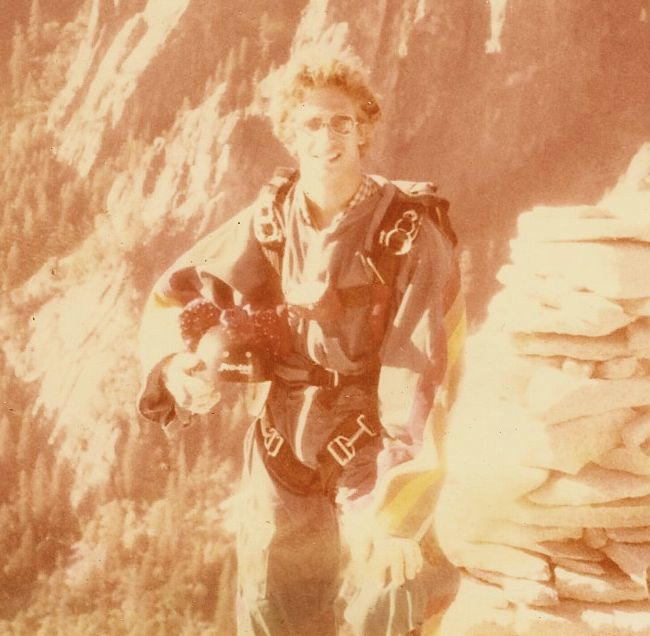Recommended Posts
Thank you for that P ...
The overall message I'm getting is that one's much more likely to die from NOT deploying their reserve (when needed) than he/she is from deploying it and having a malfunction ...
O
The overall message I'm getting is that one's much more likely to die from NOT deploying their reserve (when needed) than he/she is from deploying it and having a malfunction ...
O
bpeck 0
I dont think many of the folks this has happened to are around to comment.
QuoteI dont think many of the folks this has happened to are around to comment.
JohnRich 4
QuoteThe overall message I'm getting is that one's much more likely to die from NOT deploying their reserve (when needed) than he/she is from deploying it and having a malfunction...
Ding ding ding! You're a winner, O.
If you need it, don't be afraid of it.
tbrown 26
QuoteThank you for that P ...
The overall message I'm getting is that one's much more likely to die from NOT deploying their reserve (when needed) than he/she is from deploying it and having a malfunction ...
O
The things actually work amazingly well. Sadly, if you look in the Incidents thread, some poor guy in Germany just died because he messed around with a spinning main down to around 500 ft before he finally cutaway. His reserve was actually deploying when he hit the ground. If he'd just acted sooner, he could've written his own "my first cutaway" piece.
This really IS a no-foolin' sport. It's not for everyone. we all have to accept that the worst can happen - and then do our damndest to make sure it doesn't.
Your humble servant.....Professor Gravity !






That's ok as long as you are well aware of the time and altitude remaining, which can be the tricky bit.
Do reserves fail? Yes unfortunately they do. There is some residual risk that we aren't able to get rid of. But usually the choice of going to one's reserve is pretty simple and makes complete sense.
How likely is it for the reserve to fail? That can be interpreted either as reserves failing "on their own" or in conjunction with other factors. While the issue was in the title of the thread it really hasn't been addressed much in the thread because statistics are hard to come by.
There is no perfect definition of what failures to include on some accident list like this, what counts as valid vs. not really what we care about at this time. One can always chose to exclude "people not like oneself", such as students, or tandems, or reserve failures that happened to men, but at some point that's starting to ignore cases that do have at least some relevance.
One of the worst reserve failures, is the reserve not clearing the freebag. I recall reading in the USPA magazine years ago of it happening. (To someone trying out for AFF instructor rating. One never knows, but without other evidence one normally assumes someone experienced will be stable for reserve deployment.) There have been other cases where it happened, but where it clearly related to the bag getting tumbled out of the reserve tray and then wrapping in its own reserve lines in some way. (E.g., due to a simultaneous main canopy opening shock or something similar. Happened to a student in Canada 5-10 years back and a tandem in the US more recently.) In earlier years we had a couple skydivers blow up their squre reserves, but that tended to involve issues of high speed and excessive weight.
What are the chances of a reserve failing? (In some undefined 'serious' manner.)
I tend to throw out a number like 1 in 10,000 on the guess that reserve mals are an order of magnitude less likely than main mals, for which a number like 1 in 1000 is often thrown about. That would be due to more conservative design, very careful packing, lack of wear, and some other details that are less prone to problems than with main canopies
1 in 10,000 doesn't sound great. It sure isn't "1 in a million". If it helps, the maternal death rate when giving birth is about 1 in 10,000 last I heard in the USA.
Let's try to look at some numbers for reserve failures in the USA:
Let's look only at reserve related fatalities, as finding out about other reserve failures is harder to do.
I looked at accidents listed in the Skydiving Fatalities part of the Safety section of dz.com. For 2004 through present (June '09) there are 19 fatalities listed under "reserve problems". DZ.com's fatality list isn't perfect but is reasonable close to USPAs (which may not be perfect either). (E.g., 2004-2008 USPA shows 117 fatalities, DZ.com 120.)
Looking at the 19 fatalities, taking only ones in the USA, there were 7 incidents (8 fatalities since one was a tandem pair). I then eliminated regular main-reserve entanglements, where the problem occurred because the jumper did or had to fire their reserve into a main that wasn't cleared. They're just as dead but we'll say for our purposes that it wasn't really the reserve's fault.
That left 2 that could have fairly purely been a reserve failure:
-- tension knots on a reserve
(the reserve may have been wet, but there's little consensus on how that actually may have changed things, other than a convenient thing to point to)
-- a reserve that just didn't fully inflate (Or was it tumbling related? The reports are very unclear, so putting it into this category is uncertain.)
Then there were 3 more where the reserve failed because of some temporary or permanent interference with the jumper's body, so it wasn't necessarily the canopy's fault, but the whole deployment sequence:
-- a student who entangled with the reserve system when unstable after cutaway (accidentally pulled cutaway handle just as the main snapped open)
-- another student who entangled with the reserve system (tumbling, AAD fire)
-- a tandem where the reserve had so many line twists the canopy couldn't inflate much beyond a snivel (The problem likely started with a temporary horseshoe of the reserve PC or bridle caught on the jumpers, with the bag likely spinning during that time. One could remove the tandem from the list because they have more stability problems on cutaways, but I'll leave it in since unstable reserve deployments are not unique to them.)
So we have 2 fatalities (or maybe just 1) out of 124 that related to the reserve not working on its own, and 5 of reserves failing where one also includes interference with a clean deployment of the reserve system. The numbers are small but not negligible.
Can we assign a "1 in X" value to these reserve failures?
I'll try it but it is all pretty speculative due to not knowing how many reserve uses there are, and how rarely reserves fail (so that 1 incident more or less changes the stats radically).
UPSA estimates about 2.1 to 2.2 million non-student jumps per year from '04 on. [USPA 2008 fatality report]. Let's say it was 2.1 million a year to be conservative. Main canopies malfunction say 1 in 1000 uses. That would give 2100 reserve rides a year. But maybe the main mal rate really is higher when one includes every factor preventing the main from opening (even if it isn't the canopy's fault), because there are enough dumb little things going on out there like poorly packed pilot chutes, chopping from a popped toggle, etc. So lets try 1 in 700 is a mal, which would give 3000 reserve uses per year.
Since this is for non-students only, remove the students from our reserve failure list:
That leaves 2 (or maybe just 1) simple reserve failure, and 3 if one includes interference with the deployment. All happened in '04 through '08 so that’s compared to 4 years of maybe 3000 reserve deployments a year, or 12,000 total (if believing the 1 in 700 mal rate).
So are the numbers? 1 in 12,000 maybe, or 2 in 12,000, or 3 in 12,000 depending on the data chosen. (For non-students in the USA 2004 through 2008.) Well, those chances are higher than I'd like to see, but as I said, the data supporting that is vague, with any one incident greatly affecting the ratio. For lack of better data, I think I'll still just quote 1 in 10,000 if someone asks about a pure reserve failure, but the likelihood could easily be at least doubled when one includes interference with a clean reserve deployment.
Share this post
Link to post
Share on other sites